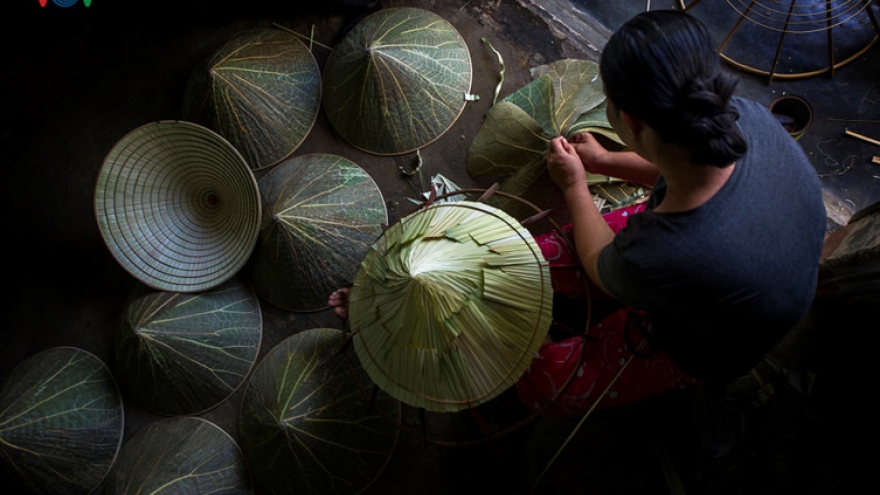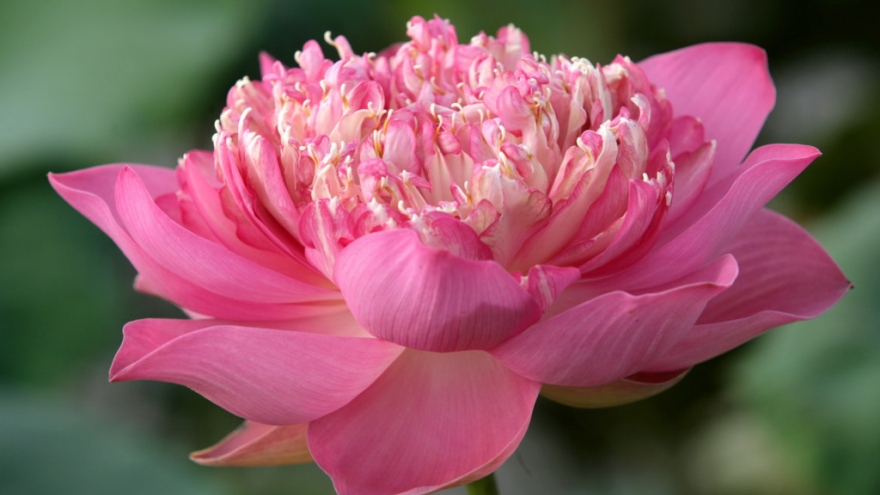Lotus farm-tourism model faces market hurdles in Mekong
Tuesday, 16:12, 20/02/2018
Nguyen Van Hon has been a farmer all of his life. Now, in his mid 50s, he is working as a tour guide.
Hon is one of the first lotus farmers in the Mekong Delta to adopt the lotus–ecotourism model as an alternative to growing an unsustainable third rice crop every year (called the autumn-winter crop).
The owner of 4ha of lotus in My Hoa commune in Dong Thap province’s Thap Muoi district, Hon began offering tourism services in 2013 when locals set up the Dong Sen (lotus farm) ecotourism zone.
His business began to take off about two to three years ago, and during peak season from June to August, he welcomes around 50-100 tourists a day.
Visitors to his farm can pick lotus flowers and enjoy lotus specialties like salted roasted lotus seeds, rice cooked with lotus, sweet lotus dessert, and fresh lotus seeds.
“When I was growing only rice and lotus, my income was quite good, but when I started the tourism business, it definitely improved,” he said. “Last year, visitors from HCM City, Dong Nai province and even the central and northern regions came here.”
Over a period of four years, his business expanded by four-fold.
The Dong Sen ecotourism zone has now expanded to 11ha, with tourism services the main source of income for local farmers taking part in the model, according to local authorities.
In the first half of 2017, the zone welcomed more than 36,000 local and international visitors and grossed more than 2.1 billion VND (92,000 USD).
Though the province has encouraged more farmers to join the ecotourism model, not everyone has the skills needed to offer good services or the finances to invest in infrastructure.
Tran Van Kich, who has a 4.5ha area of lotus flowers only a 20-minute riverboat ride away from Hon’s farm, has decided to breed fish on his lotus farm to increase income.
But unlike the lotus–ecotourism model in which the lotus output is bought by tourists, farmers like Kich who rely on selling lotus seeds are worried about the price fluctuations of lotus.
“I’m not sure if I can sell lotus flowers at good prices this year,” he said.
As he only sells fresh lotus seeds, he has to rely on prices offered by traders who visit his farm to buy lotus seeds and flowers directly from him.
Sometimes traders are willing to pay 12,000 VND per kilogramme, but later change their minds to 10,000 VND or even 8,000 VND after the lotus is picked, saying the plants are not “beautiful”, according to Kich.
Farmers have to sell the lotus plants soon after they picked, he said, because they could lose freshness if they are stored overnight.
“Unstable prices discourage farmers,” he said. “Besides, it’s not easy to find lotus pickers since many of them have moved to other places to work in factories or at construction sites.”
When asked why he still grows lotus even though many neighbours have stopped, he said: “My first thought was that I am doing this for the environment.”
Lotus leaves can also be a good source of organic fertiliser, he said.
“After harvesting lotus and preparing for the next rice crop, I only need to use half of the fertiliser volume compared to other rice fields,” he added.
The income from selling fish also helps him cover the expenses of growing lotus.
Many provinces in the delta such as Long An and An Giang have followed suit and adopted several flooding-based livelihood models to reduce production of the third rice crop and create jobs during the flooding season. But they have also faced market challenges.
Nguyen Chi Thien, Deputy Director of Long An province’s Department of Agriculture and Rural Development, said that many models were being adopted, but finding the right markets for farmers remains a problem.
He cited the example of the ro (anabas) fish – rice model.
“When it was first implemented, the fish sold for 30,000 VND per kilogramme. But when it was widely adopted, fish prices dropped nearly one-half,” he said.
External factors such as food scams and fish disease outbreaks have also affected prices, he added.
Dang Kim Khoi from the Institute of Policy and Strategy for Agriculture and Rural Development said the issue of markets could not be solved at a local level or for a single model.
He said the Government and the Ministry of Agriculture and Rural Development (MARD) have classified three groups of strategic agricultural products as national key products, provincial key products and local specialties.
“Each group needs to be addressed differently,” he said.
For example, for national key products, there should be a nationwide supply-demand assessment to avoid oversupply, which leads to a fall of prices in domestic and international markets, he added.
“For this to happen, enterprises and farmers cannot do it alone, and the Government must play the role of an enabler and leader with support from other ministries and research institutes,” he said.
Similarly, for provincial key products and local specialties, local authorities should take the leading role and follow guidance from the ministries, he said.
At the moment, MARD is developing a programme on enhancing agribusiness capacity for farmers and enterprises which will be piloted in Can Tho city and Tay Ninh and Nghe An provinces.
“Through this programme, based on assessing selected key agricultural products, we will identify our weaknesses and fill the holes. And through this, we’ll be able to see what the Government must do and where the private sector has to give a hand,” he added.
The owner of 4ha of lotus in My Hoa commune in Dong Thap province’s Thap Muoi district, Hon began offering tourism services in 2013 when locals set up the Dong Sen (lotus farm) ecotourism zone.
 |
Visitors to his farm can pick lotus flowers and enjoy lotus specialties like salted roasted lotus seeds, rice cooked with lotus, sweet lotus dessert, and fresh lotus seeds.
“When I was growing only rice and lotus, my income was quite good, but when I started the tourism business, it definitely improved,” he said. “Last year, visitors from HCM City, Dong Nai province and even the central and northern regions came here.”
Over a period of four years, his business expanded by four-fold.
The Dong Sen ecotourism zone has now expanded to 11ha, with tourism services the main source of income for local farmers taking part in the model, according to local authorities.
In the first half of 2017, the zone welcomed more than 36,000 local and international visitors and grossed more than 2.1 billion VND (92,000 USD).
Though the province has encouraged more farmers to join the ecotourism model, not everyone has the skills needed to offer good services or the finances to invest in infrastructure.
Tran Van Kich, who has a 4.5ha area of lotus flowers only a 20-minute riverboat ride away from Hon’s farm, has decided to breed fish on his lotus farm to increase income.
But unlike the lotus–ecotourism model in which the lotus output is bought by tourists, farmers like Kich who rely on selling lotus seeds are worried about the price fluctuations of lotus.
“I’m not sure if I can sell lotus flowers at good prices this year,” he said.
As he only sells fresh lotus seeds, he has to rely on prices offered by traders who visit his farm to buy lotus seeds and flowers directly from him.
Sometimes traders are willing to pay 12,000 VND per kilogramme, but later change their minds to 10,000 VND or even 8,000 VND after the lotus is picked, saying the plants are not “beautiful”, according to Kich.
Farmers have to sell the lotus plants soon after they picked, he said, because they could lose freshness if they are stored overnight.
“Unstable prices discourage farmers,” he said. “Besides, it’s not easy to find lotus pickers since many of them have moved to other places to work in factories or at construction sites.”
When asked why he still grows lotus even though many neighbours have stopped, he said: “My first thought was that I am doing this for the environment.”
Lotus leaves can also be a good source of organic fertiliser, he said.
“After harvesting lotus and preparing for the next rice crop, I only need to use half of the fertiliser volume compared to other rice fields,” he added.
The income from selling fish also helps him cover the expenses of growing lotus.
Many provinces in the delta such as Long An and An Giang have followed suit and adopted several flooding-based livelihood models to reduce production of the third rice crop and create jobs during the flooding season. But they have also faced market challenges.
Nguyen Chi Thien, Deputy Director of Long An province’s Department of Agriculture and Rural Development, said that many models were being adopted, but finding the right markets for farmers remains a problem.
He cited the example of the ro (anabas) fish – rice model.
“When it was first implemented, the fish sold for 30,000 VND per kilogramme. But when it was widely adopted, fish prices dropped nearly one-half,” he said.
External factors such as food scams and fish disease outbreaks have also affected prices, he added.
Dang Kim Khoi from the Institute of Policy and Strategy for Agriculture and Rural Development said the issue of markets could not be solved at a local level or for a single model.
He said the Government and the Ministry of Agriculture and Rural Development (MARD) have classified three groups of strategic agricultural products as national key products, provincial key products and local specialties.
“Each group needs to be addressed differently,” he said.
For example, for national key products, there should be a nationwide supply-demand assessment to avoid oversupply, which leads to a fall of prices in domestic and international markets, he added.
“For this to happen, enterprises and farmers cannot do it alone, and the Government must play the role of an enabler and leader with support from other ministries and research institutes,” he said.
Similarly, for provincial key products and local specialties, local authorities should take the leading role and follow guidance from the ministries, he said.
At the moment, MARD is developing a programme on enhancing agribusiness capacity for farmers and enterprises which will be piloted in Can Tho city and Tay Ninh and Nghe An provinces.
“Through this programme, based on assessing selected key agricultural products, we will identify our weaknesses and fill the holes. And through this, we’ll be able to see what the Government must do and where the private sector has to give a hand,” he added.


